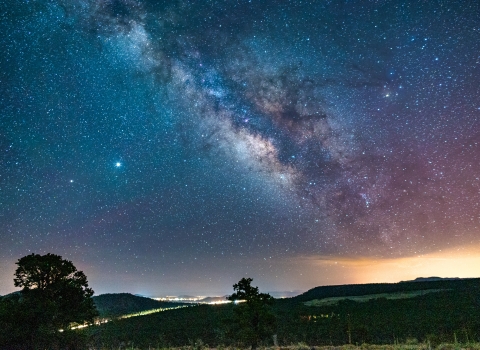The Hyatt Hidden Lakes Reserve in Boise, Idaho is a 44-acre urban reserve. It provides habitat for a multitude of species such as red-winged blackbirds, gadwalls, Pied-billed Grebes, snakes, and others. The welcoming paths give visitors a quick and easy way to add nature into their day.
But the reserve does more than provide wildlife habitat in the city, it also provides a place for people arriving in Boise from all over the globe to connect to their new home. On a cool early, summer day, more than 40 adult students from the English Language Center took a field trip to the reserve organized by the Hyatt Hidden Lakes Reserve Habitat Enhancement project, the USFWS is a project partner. Some students brought their children, so it was a noisy, as the multi-generational group got off the bus. The students eagerly picked up binoculars and headed off down the path with volunteers ready to point out the native plants and animals.
There were exclamations of excitement over the birds. “See the bird nest?” said Allyson Turner of the Fish and Wildlife Service. “This is where the baby birds hatch,” she said while cradling an imaginary baby in her arms. Smiles of recognition and excitement followed. Everyone connects with and loves to hear about babies.
The students got a pleasant surprise when they were asked to rub the sagebrush sagebrush
The western United States’ sagebrush country encompasses over 175 million acres of public and private lands. The sagebrush landscape provides many benefits to our rural economies and communities, and it serves as crucial habitat for a diversity of wildlife, including the iconic greater sage-grouse and over 350 other species.
Learn more about sagebrush leaves between their fingers and take a whiff.
“Smells like Boise,” one volunteer said, and this was repeated by the student with a large grin. “Yes, smells like Boise.” Some of the students picked flowers found around the reserve and put them in their hair, and everyone laughed when ducklings made an appearance.
The afternoon ended with lunch and a few photos before the students headed home. Regardless of the students’ ages or circumstances, I think it was unanimous that Boise is a cool place to live, with lots of natural space and opportunity- even in the middle of the city.
A simple field trip like this is a great way to connect people to their natural world. It also can lead to a whole new generation of biologists — some of the visitors may decide to become conservation professionals.
Volunteering for the field trip gave me first-hand experience with people from other cultures. I grew up in Idaho where there’s little ethnic diversity. I really enjoyed the chance to grow by meeting people who didn’t grow up like I did. Clearly, Idaho is changing, and my participation in this event reinforced the positive aspects of growth and change.
An important part of the Hyatt Hidden Lakes Reserve Habitat Enhancement project is to connect people, especially those from other cultures, to nature. The more people who appreciate our natural world the way I do, the more voices of support there will be for habitat enhancement. Whether we grew up in Boise or are newly arrived, everyone that day seemed to appreciate the place we call home.


